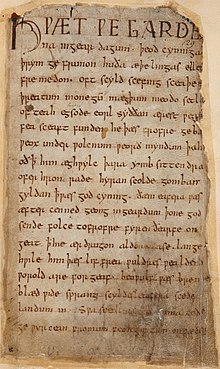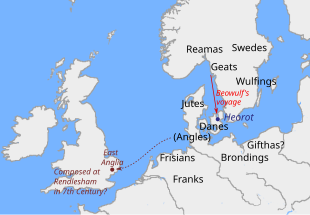Heorot

Heorot(Old English'hart, stag') is amead-halland major point of focus in theAnglo-SaxonpoemBeowulf.The hall serves as a seat of rule for KingHrothgar,alegendary Danish king.After the monsterGrendelslaughters the inhabitants of the hall, theGeatishheroBeowulfdefends the royal hall before subsequently defeating him. LaterGrendel's motherattacks the inhabitants of the hall, and she too is subsequently defeated by Beowulf.
Name[edit]
The nameHeorotis the Old English word for astag.[1]Its use may stem from an association between royalty and stags inGermanic paganism.Archaeologists have unearthed a variety of Anglo-Saxon finds associating stags with royalty. For example, a sceptre or whetstone discovered in mound I of the Anglo-Saxon burial siteSutton Hooprominently features a standing stag at its top.[2]
In a wider Germanic context, stags appear associated with royalty with some frequency. For example, inNorse mythology—the mythology of the closely related North Germanic peoples—the royal godFreyr(Old Norse: "Lord" ) wields an antler as a weapon. An alternative name for Freyr isIng,and the Anglo-Saxons were closely associated with this deity in a variety of contexts (they are, for example, counted among theIngvaeones,a Latinized Proto-Germanic term meaning "friends of Ing", in Roman senatorTacitus's first century CEGermaniaand, inBeowulf,the termingwine,Old English for "friend of Ing", is repeatedly invoked in association with Hrothgar, ruler of Heorot).[3]
According to historianWilliam Chaney:
Whatever the association with the stag or hart with fertility and the new year, with Frey, with dedicated deaths, or with primitive animal-gods cannot now be determined with any certainty. What is certain, however, is that the two stags most prominent from Anglo-Saxon times are both connected with kings, the emblem surmounting the unique 'standard' in the royal cenotaph of Sutton Hoo and the great hall of Heorot inBeowulf.[4]
Description[edit]

Theanonymousauthor ofBeowulfpraises Heorot as large enough to allow Hrothgar to present Beowulf with a gift of eight horses, each with gold-plate headgear.[5]It functions both as a seat of government and as a residence for the king'sthanes(warriors). Heorot symbolizes human civilization and culture, as well as the might of the Danish kings—essentially, all the good things in the world ofBeowulf.[6]Its brightness, warmth, and joy contrasts with the darkness of the swamp waters inhabited byGrendel.[7]
Location[edit]
Harty, Kent[edit]
Though Heorot is widely considered a literary construction, a theory proposed in 1998 by the archaeologist Paul Wilkinson has suggested that it was based on a hall atHartyon theIsle of Sheppey,which would have been familiar to the anonymous Anglo-Saxon author; Harty was indeed named Heorot in Saxon times. He suggests that the steep shining sea-cliffs ofBeowulfwould match the pale cliffs ofSheernesson that island, its name meaning "bright headland". An inlet near Harty is named "Land's End", like Beowulf's landing-place on the way to Heorot. The sea-journey from theRhinetoKentcould take the day and a half mentioned in the poem. The road to Heorot is described as astraet,aRoman Road,of which there are none in Scandinavia, but one leads across the Isle of Harty to a Roman settlement, possibly a villa. ThetoponymistMargaret Gellingobserved that the description inBeowulfof Heorot as having afagne flor,a shining or coloured floor, could "denote the paved ortessellated floorof a Roman building ". Finally, the surrounding area was namedSchrawynghopin the Middle Ages,schrawameaning "demons" andhopmeaning "land enclosed by marshes", suggestive ofGrendel's lonely fens in the poem.[8][9]The archaeologist Paul Budden acknowledged "the story appealed" to him as a Kentish man, but felt that (as Wilkinson conceded) the subject was "mythology, not archaeology or science".[10]
Lejre, Zealand[edit]

An alternative theory sees Heorot as the accurate, but Anglicised, iteration of a historic hall in the village ofLejre,nearRoskilde.[11]Though Heorot does not appear in Scandinavian sources, KingHroðulf's (Hrólfr Kraki) hall is mentioned inHrólf Kraki's sagaas Hleiðargarðr, and located in Lejre. The medieval chroniclersSaxo GrammaticusandSven Aggesenalready suggested that Lejre was the chief residence of theSkjöldungclan (called “Scylding” in the poem). The remains of aVikinghallcomplex was uncovered southwest of Lejre in 1986–1988 by Tom Christensen of the Roskilde Museum. Wood from the foundation wasradiocarbon-dated to about 880. It was later found that this hall was built over an older hall which has been dated to 680. In 2004–2005, Christensen excavated a third hall located just north of the other two. This hall was built in the mid-6th century, all three halls were about 50 meters long.[7]
Fred C. Robinson is also attracted to this identification: "Hrothgar (and later Hrothulf) ruled from a royal settlement whose present location can with fair confidence be fixed as the modern Danish village of Leire, the actual location of Heorot."[12]The role of Lejre inBeowulfis discussed byJohn NilesandMarijane Osbornin their 2007Beowulf and Lejre.[13]
Modern popular culture[edit]
J. R. R. Tolkien,who compared Heorot toCamelotfor its mix of legendary and historical associations,[14]used it as the basis for the Golden Hall of KingThéoden,Meduseld,in the land ofRohan.[15]
The Legacy of Heorotis ascience fictionnovel by American writersLarry Niven,Jerry Pournelle,andSteven Barnes,first published in 1987.[16]
"Heorot" is a short story inThe Dresden Files'short story collectionSide Jobs.
InZach Weinersmith's bookBea Wolf(2023), Heorot is paralleled by the treehouse Treeheart.
See also[edit]
- Eikþyrnir,the stag that stands atop Odin's afterlife hall Valhalla in Norse myth
- Dáinn, Dvalinn, Duneyrr and Duraþrór,the stags that chew on the cosmological tree Yggdrasil in Norse myth
- Freyr,a Germanic deity who wields an antler as a weapon and whose name means 'lord'
- Valhalla,the afterlife hall of Odin in Norse myth, featuring a stag at its top
Notes and citations[edit]
- ^"Old English Translator".
- ^For general discussion, see Fulk, Bjork, &Niles(2008:119–120). For images and details regarding the sceptre or whetstone, see theBritish Museum'scollection entry for the object here.
- ^See discussion in, for example, Chaney (1999 [1970]:130–132).
- ^Chaney (1999 [1970]:132).
- ^Beowulf,lines 1035–37
- ^Halverson, John (December 1969). "The World of Beowulf".ELH.36(4): 593–608.JSTOR2872097.
- ^abNiles, John D.,"Beowulf's Great Hall",History Today,October 2006,56(10), pp. 40–44
- ^Hammond, Norman (7 December 1998). "How Beowulf's lair was pinned down to the Thames Estuary".The Times.
- ^Wilkinson, Paul (2017).Beowulf - On the Island of Harty in Kent.Kent Archaeological Field School.ASINB07Q27K3XG.
- ^Budden, Gary (2017)."Background reading: Beowulf in Kent by Dr Paul Wilkinson"(PDF).Kent Archaeological Field School Newsletter(16 (Christmas 2017)): 22–23.Retrieved9 December2020.
- ^Lapidge, Michael; Godden, Malcolm (1991).The Cambridge companion to Old English literature.Cambridge University Press. p. 144.ISBN978-0-521-37794-2.Retrieved22 May2010.
- ^Robinson, Fred C. (1984). "Teaching the Backgrounds: History, Religion, Culture". In Jess B. Bessinger, Jr. and Robert F. Yeager (ed.).Approaches to Teaching Beowulf.New York: MLA. p. 109.
- ^Niles, John;Osborn, Marijane(2007).Beowulf and Lejre.Arizona Center for Medieval and Renaissance Studies.ISBN978-0-86698-368-6.
- ^Tolkien, J. R. R.,Beowulf: A Translation and Commentary(2015), p. 153.
- ^Shippey, Tom,J. R. R. Tolkien: Author of the Century(2001), p. 99.
- ^Dryden, Mary (2 August 1987)."The Legacy of Heorot by Larry Niven, Jerry Pournelle and Steven Barnes; maps by Alexis Walser".Los Angeles Times.Retrieved13 January2021.
References[edit]
- Chaney, William A.1999 [1970].The Cult of Kingship in Anglo-Saxon England: The Transition from Paganism to Christianity.Manchester University Press.ISBN0719003725
- Fulk, R.D.; Bjork, E. Robert; &Niles, John D.2008.Klaeber's Beowulf.Fourth edition.University of Toronto Press.ISBN9780802095671

